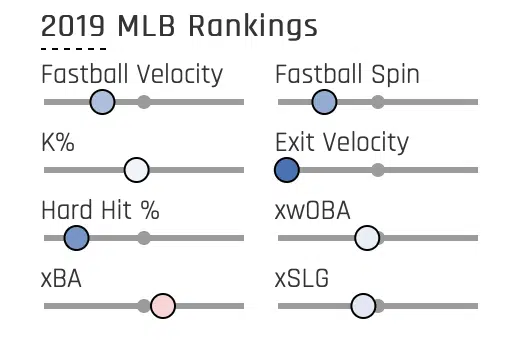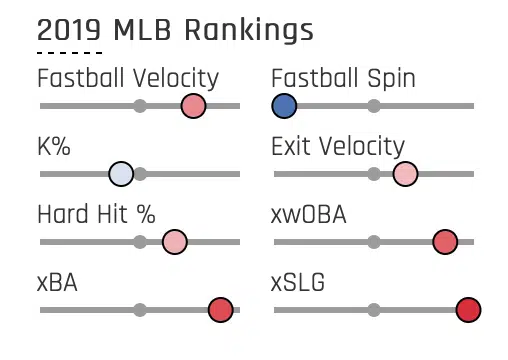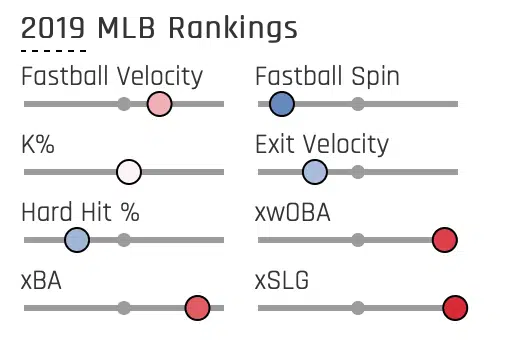Last offseason, the White Sox traded for their 2019 and – assumedly – 2020 closer when they sent Omar Narvaez to the Mariners in exchange for Alex Colome. Colome, by most standards, has had a good season. He is 30/33 in save opportunities, becoming the first White Sox closer since David Robertson to close 30 games in a season for the Sox. Heading into 2020, odds are that Colome will be the deserving leader to be named the closer of what should be a competitive team. However, due to a second half that is much more representative of the pitcher Colome is than the first half, I don’t believe Colome should go into 2020 without some competition for the closer role.
The first thing I want to get out of the way is that this is NOT an article that was written because of the blown save last night. My thoughts on Colome have been pretty scattered all season, to be completely honest with you. But the more I dive into the numbers, the more I have long-term concerns about Colome’s role heading into 2020. Frankly, his second half is only confirming my suspicious. Here’s what I’ve seen:
ERA/FIP Splits and Resultant Second Half Regression
(Quick Aside for Clarification: FIP stands for Fielding Independent Pitching. This statistic converts the three outcomes a pitcher can control – walks, strikeouts, and home runs – into a number that resembles ERA. The rule of thumb is that, over the course of a season, a pitcher’s ERA will tend towards his FIP. So, if Pitcher A has a 4.00/3.00 ERA/FIP, I would tell you that he is underperforming expectations and his ERA is likely to improve. If those numbers were flipped, I would tell you he is likely to regress.)
Every argument I make about Alex Colome tends to come from this starting point. Indeed, everything I say after this was informed by this ERA/FIP split. Let’s talk about Alex Colome in the first half. His 2.02 ERA would likely lead you to telling me he is a lockdown closer who had a great first half and should be out closer moving forward. However, his first half FIP was 4.00 – a full two runs higher than his ERA. So, my response would be that yes, he was good, but I have concerns about how good he will be in the second half.
After last night, his second half ERA is 3.91 (looks like that first half FIP). His second half FIP? 4.20.
So, what we have here is an example of a pitcher regressing to his expected statistics. Are the rest of his stats showing this? Well, here’s a slash line breakdown of first half to second half:
First Half: .127 AVG / .194 OBP / .288 SLG / .206 wOBA / .327 xwOBA
Second Half: .265 AVG / .347 OBP / .422 SLG / .322 wOBA/ .320 xwOBA
I bolded his first half expected wOBA (xwOBA) and his second half wOBA for the same reason I pointed out the ERA/FIP split: the numbers clearly thought Alex Colome was pitching better than expected in the first half. And, as a result, his second half numbers have regressed significantly. According to ERA/FIP and xwOBA, the second half Alex Colome is the “real” version of 2019 Alex Colome, for the lack of a better word. His expected statistics are much closer to his actual statistics this half. That’s not a good thing.
What has this regression been fueled by? Well, I think it starts with his walk rate. Colome is putting a lot more runners on base by free passes. He went from 2.52 BB/9 in the first half to a 4.62 BB/9 in the second half. For pitchers, this can only be a bad thing. Here’s the bigger problem with his walk rate: he hasn’t really done a great job of preventing those runners from scoring in the second half. Enter LOB%….
LOB%
Let’s talk about one of the most concerning parts for me when it comes to Colome: LOB%. This stands for Left On Base Percentage, and this is exactly what it sounds like: what percentage of baserunners does a pitcher strand on base?
As you can probably tell, a higher percentage for LOB% is better – less of the runners a pitcher allows to reach base score. And, as you might also expect, the better pitchers across the league tend to have high LOB%. It’s not an exact relationship, but it’s a decent one.

In the first half, Alex Colome’s LOB% was 87.6% – which would’ve put him in the upper tier of relievers. But, by this point in the article, I bet you can guess what’s coming next. His second half LOB%: 57.1%. This means that close to half of the runners that reach base against Colome have scored this second half. In high leverage situations – the ones most of us consider the most important for a closer – Colome’s LOB% is only 67.4%, and to make it worse, he has a 5.71 BB/9 in those situations. Here’s another staggering number: with runners on base, Colome’s LOB% this season is 19.8%. For comparison, with runners on base this season, Josh Hader‘s LOB% is 61.7%. So, there’s quite the gap between one of the game’s best and Alex Colome when it comes to pitching with runners on base.
LOB% really speaks for itself. If, the majority of the time, Colome is coming into a clean inning with no one on base, it isn’t great that he’s creating problems for himself with a 4.62 BB/9. It helps even less that his LOB% is so poor this second half – he can’t really afford to put himself in tough situations.
All of this stems from another big problem of Colome’s, in my opinion. When compared to other closers, in general, his pure “stuff” just isn’t that overpowering.
Pure “Stuff” and GB/FB%
If you’ve read my work, you know I’m a big fan of fastball velocity and spin rate comparisons. So, let’s look at those, and a few more metrics, from Colome:

None of this is really good by any stretch of the word. These metrics are pretty bad for a closer. Usually, if a fastball has a lower average velocity, a pitcher makes up for it with impressive spin rate. On the flip side, pitchers with serious heat can get away with low spin rate on a fastball if their secondary stuff is good. In the case of Colome, he has neither velocity or spin rate on his fastballs. That, in general, is concerning to me. When you look at the numbers, my concerns are justified: hitters are hitting .273 against Colome’s fastball this year and slugging .568 with a wOBA of .417. This is horrendous. But, Colome’s cutter is a good pitch: .174 AVG with a .222 wOBA. However, those are Colome’s only two pitches: he barely throws a changeup. If one pitch gets hammered, and a pitcher only has two pitches, it doesn’t bode well for long-term success. What else can he turn to? With no off speed pitch and two pitches with less than ideal metrics, Colome’s pure “stuff” is lacking for a closer.
This leads me to Colome’s GB/FB%. Typically, if your stuff isn’t great as a pitcher, you’d like to keep the ball out of the air. However, Colome has a 37% FB% this year. He has improved in the second half on his FB%, sitting down at just 30%. However, more of those fly balls have turned into line drives, as his LD% jumped from 15% to 21% from the first to the second half. So, it’s not as if hitters are getting any less solid contact against Colome in the second half – the fairly consistent 38% and 36% hard-hit % by half shows this. Rather, hitters are hitting the ball harder this half – his soft contact % has dropped from 10% to 6% in the second half.
Most closers get away with having only two pitches because their stuff is overpowering. This is not the case for Colome. Hitters have figured him out much better in the second half, and based on these numbers, I’m not expecting much improvement – his expected numbers and actual numbers are much closer together in the second half than they were in the first half. I’m not saying he isn’t a good pitcher that the White Sox will need in the bullpen. I’m just saying his role shouldn’t be locked down.
Do I Have a Better Option? I Think So
Let’s start with a couple graphics:
Pitcher A

Pitcher B

This isn’t a perfect comparison, but any guesses? It’s not that easy.
Pitcher A is Zack Britton. Pitcher B is my option for 2020 closer: Aaron Bummer.
Let’s say the White Sox make this change internally. In that case, their best option is to give Aaron Bummer a chance to close. Now, those graphics are just for fun; in reality, Britton and Bummer’s similarities are a lot deeper than you would think. It starts with their repertoires: both pitcher’s feature a power sinker that allows them to get A LOT of ground balls in a game obsessed with launch angle. Britton’s GB% in 2019 is 76.9% on the season. This leads all major league relievers. In second place? Aaron Bummer and his 72.2% GB%. No other qualified reliever in the majors is above 70% in GB%. Bummer has molded himself in the form of Zack Britton: use the sinker to get hitters to hammer the ball into the ground. With the launch angle revolution and juiced baseballs, fewer bad things can happen when the ball is hit on the ground.
Britton and Bummer are two pitchers who fit the mold I described above: pitchers that get away with having just two or three pitches because they’re just incredibly overpowering. Take a look at their fastball velocities above. By all metrics, Bummer’s year does not seem to be a fluke either: his season wOBA is .236. His expected wOBA (xwOBA) is .256. Both of these values are in the top 7% of the league this year. Here’s what I find absolutely nuts: the average launch angle off of Aaron Bummer this season is -3.4 degrees. Think about what that means: hitters are literally beating the ball into the ground against Bummer. For comparison, Britton’s average launch angle against is -8.7 degrees. These guys are a lot more similar than you’d think.
Britton found success as the closer in Baltimore before joining the beast that is the New York Yankees’ bullpen. He lost his closer role not because he was bad, but because Aroldis Chapman is just that good. So, if Britton excelled in the closer role, and Bummer is built similarly to Britton, why not give Bummer the chance to close next year?
If Not Bummer, Who Else?
I also don’t like the idea of limiting Bummer to a closer. Being able to bring him in during a crucial situation in the sixth – like they did last night – is incredibly important to me. I love Bummer’s flexibility – which is also what I think would make him a good closer. More on flexibility in the next section.
The reality is that, as currently constructed, it would be hard for the White Sox to deviate from their current bullpen construction. Bummer’s versatility is so valuable that he could theoretically be named the closer of the 2020 White Sox but not pitch as much in the ninth as anyone would think. That would result in Alex Colome getting a lot of save situations once again, which would beg the question: Why make the change in the first place? So, if I’m committed to Bummer’s flexibility, I still need another option. This would require a stab at free agency. My target: Will Smith, LHP, SFG.
At 29 years old, Smith has turned himself into an excellent closer this season. He has 34 saves for a pretty bad Giants team with a 13.2 K/9 and 2.9 BB/9. Let’s check the rest of the numbers, to be fair in the analysis:
First Half: .168 AVG / .218 OBP / .272 SLG / .213 wOBA / .231 xwOBA / 1.93 ERA / 2.02 FIP/ 84.7 LOB%
Second Half: .227 AVG / .306 OBP / .455 SLG / .313 wOBA / .301 xwOBA / 3.72 ERA / 4.73 FIP/ 92.2 LOB%
So, it’s been a tale of two halves for Smith. First half Smith was very very good – and his expected numbers backed it up, which is the difference between Smith and Colome in the first half. Second half Smith, well, not so much. He has seen his fly ball rate increase 10 percentage points from 30% to 40% in the second half, which has a lot to do with his poor second half numbers and likely would not play well at Guaranteed Rate Field. Is he the type of player I would say the Sox should go out, sign, and immediately make him their closer? No. My point is that the White Sox need bullpen help from the outside, and they should consider signing that bullpen help and creating a closer competition in Spring Training. Will Smith is a proven closer who has the ability to work late in the ballgame. This is absolutely a RP who, in a thin market, the White Sox should set their sights on heading into 2020. The bullpen as currently constructed needs to be augmented with more proven talent. It will be difficult to do with a thin market, which is why the White Sox should keep their eye on the valuable few in the market.
Final Thoughts: Bad Bullpen Utilization? Not in Today’s Game
I fault Ricky Renteria for A LOT of things – I have never been his most avid supporter. However, one thing I have rarely faulted him on is his use of Alex Colome.
One common response to my criticisms of Colome has gone something like this: “Well he’s 30/33 in save situations and really good in them, and pitching poorly in non-save situations is about bad bullpen utilization.” My response, in more than 280 character on Twitter, in this:
- Yes, on the whole, people who say this are correct. Colome is worse outside of save situations. But in those non-save situations, Colome is still throwing the same pitches. There is no quantifiable reason why Colome would be so much worse in a non-save situation. In reality, if the Sox are using him outside of these situations, it’s likely because the game is on the line and they need him to get some crucial outs.
- I know, I know, being a closer is a mentality. But think of some of the most recent playoff teams. Andrew Miller and the 2016 Indians. Kenley Jansen and the 2017/2018 Dodgers. Josh Hader and the 2018 Brewers. Aroldis Chapman and the 2016 Cubs. One of these is not like the other, and that’s Chapman in 2016. Chapman’s inability to really pitch outside of the ninth inning almost cost the Cubs Game 7. Miller, Hader, and Jansen were all the closers on their respective teams. None of them only pitched in save situations in the ninth inning. They pitched when the game was on the line, no matter what inning it was, because that’s what the closer is supposed to be: your best arm who gets the most important outs of the game.
The reality is this: by definition, the “save” in the game comes in the ninth inning. But, more often than not in today’s game, that ninth inning is not the point in the game where the game is most on the line. Think of the game yesterday: bases loaded, no outs, up by two runs in the sixth. If the Sox don’t keep the lead there, there’s no chance for Colome to come on in the ninth. You can’t always plan for the ninth inning in the sixth – you have to make sure you’re getting to the ninth inning with the lead first. Bummer did a great job securing the lead in that sixth inning. The Sox didn’t save him for the eighth inning to serve as a bridge to Colome, because if the Sox lost the lead, there would be no need for a bridge.
Pitchers who can only throw in a certain situation are incredibly less valuable in baseball today due to a renewed importance to the bullpen. SP are not going as deep into games anymore, putting more pressure on the bullpen than ever. Being a one inning, one type of situation pitcher just will not work in important games that make or break a season. If the White Sox cannot trust Colome outside of a save situation, and/or if Colome cannot pitch well outside of a save situation, that is not a good thing at all.
Pitchers blow saves. It’s going to happen. Like I said, I did not write this because of the blown save. I wrote it because of the deeper problems I see with Colome’s statistics. You might read this and completely disagree with me. That’s fine, because odds are that Colome will deservedly be the White Sox’ closer in 2020 and have an overall solid year. But, on a team that is looking to be competitive heading into next year, the White Sox should explore ALL options for ALL positions moving forward next year. In today’s game, bullpens are so important to the success or failure of a team, and all too often, the bullpen becomes the Achilles’ Heel for a team (Red Sox and Cubs, anyone?).
Alex Colome should absolutely be in consideration for the closer role in 2020. But, so should Aaron Bummer, and so should any arms the White Sox add in the offseason (because they need to add some). The most competitive teams will create competition in Spring Training to get the best out of each of their players and avoid complacency. The White Sox should be prepared to do the same with their bullpen. There is definitely a need for the White Sox to evaluate each member of their bullpen and the best way for Ricky to approach situations late in the game. These decisions could be the difference between winning and losing a playoff spot – or even playoff series – in the near future.
Agree? Disagree? Let me know on Twitter: @jlazowski14
Featured Photo: White Sox


With your background in statistical analysis, please apply for a job with the White Sox. You are what this organization has lacked forever!
Thank you so much Tom, I genuinely appreciate the kind words – always nice to hear them after a long day of work! I hope you continue to enjoy our content here! Thanks for the support.